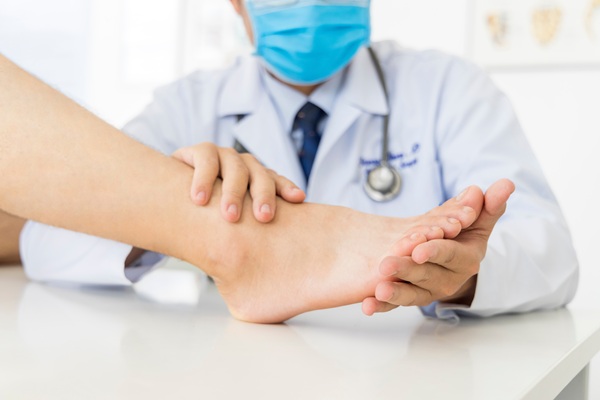Joint Pain Orthopedic CareAustell, GA
Joint pain orthopedic care offers targeted solutions to alleviate discomfort, enhance joint function, and improve a patient’s quality of life. This non-surgical approach focuses on personalized treatment plans that address the unique needs of each patient, helping patients regain mobility and lead an active lifestyle. In most cases, those who have tried other treatments without success can benefit from joint pain orthopedic care.
Delta Orthopedics offers joint pain orthopedic care to patients in Austell and the surrounding area. Call us at 678-439-5216 to request an appointment and learn more.
The Importance of Joint Pain Orthopedic Care
Individuals struggling with discomfort that limits their daily activities can benefit from joint pain orthopedic care. Since the joints are vital for movement and stability, injuries and discomfort can lead to significant disruptions in life. Whether caused by arthritis, injury, or other conditions, untreated joint issues can worsen over time and negatively impact a person’s well-being.
Orthopedic care aims to identify the root cause of joint pain and provide effective treatment that relieves symptoms, restores movement, and prevents further damage. Early intervention is key to orthopedic care as the sooner care begins, the better the outcomes. Prompt care is crucial in managing joint pain and ensuring patients can maintain an active lifestyle without relying on invasive surgical procedures.
“Orthopedic care aims to identify the root cause of joint pain and provide effective treatment that relieves symptoms, restores movement, and prevents further damage.”
Reasons You May Need This Professional Treatment
Patients may require joint pain orthopedic care for a variety of reasons. The chief reasons include the following:
- Arthritis. Condition characterized by joint inflammation, leading to pain, stiffness, and decreased mobility
- Previous Injuries. Unresolved damage caused by sports injuries, accidents, or overuse
- Bursitis. Inflammation of fluid-filled sacs in the joints, resulting in discomfort and swelling
- Chronic Pain. Persistent joint pain that will not improve with rest or over-the-counter treatments
- Limited Range of Motion. Difficulty moving joints through their full range, hindering daily activities
Recognizing these signs and promptly seeking professional treatment can prevent further complications, helping to maintain joint health.
“Recognizing these signs and promptly seeking professional treatment can prevent further complications, helping to maintain joint health.”
Treatment Benefits
Joint pain orthopedic care offers many benefits, helping patients regain mobility, reduce discomfort, and improve their overall quality of life. Below are detailed explanations of these benefits.
Long-Lasting Pain Relief
Orthopedic care provides targeted treatments to address the root causes of joint pain rather than merely masking symptoms. Through therapies such as physical rehabilitation, medications, or minimally invasive procedures, specialists work to reduce inflammation, repair damage, and restore joint health. These solutions focus on long-term solutions that allow patients to experience sustained relief that improves daily life.
Improved Mobility
Simple tasks like walking or climbing stairs can be challenging when joint pain limits movement. Therefore, orthopedic treatments aim to restore joint function, strengthen surrounding muscles, and improve flexibility. Enhancing mobility in this way can help patients reclaim their independence and confidently perform daily activities with less discomfort.
Reduced Risk of Future Damage
Ignoring joint pain can worsen conditions, including chronic inflammation or irreversible joint damage. Orthopedic care offers timely interventions to prevent the progression of joint issues, reducing the likelihood of complications such as arthritis or deformities. Thanks to early treatment, providers can help safeguard long-term joint health, preserve functionality, and prevent more invasive procedures.
Enhanced quality of Life
Chronic joint pain can harm everything from work performance to personal relationships. Therefore, orthopedic care allows individuals to re-engage in hobbies, exercise, and social activities by restoring joint health and reducing discomfort. Living without pain promotes mental well-being, energy, and a renewed sense of joy in everyday life.
Customized care plans
Effective treatment requires a personalized approach to address every patient’s unique joint pain. That is why orthopedic specialists develop tailored care plans that consider the individual’s medical history, activity level, and treatment goals, resulting in better outcomes and a smoother recovery process.
Minimally invasive care
Orthopedic providers aim for non-surgical approaches first, such as pain medications, splints or braces, or physical therapy. By leveraging advanced diagnostic tools and therapies, orthopedic care delivers effective, minimally invasive solutions for joint pain management.
"Orthopedic care provides targeted treatments to address the root causes of joint pain rather than merely masking symptoms."
The Treatment Process
The treatment process for joint pain orthopedic care begins with a thorough evaluation to determine the cause and severity of the condition. During this initial consultation, the orthopedic professional or PA-C will gather a detailed medical history and perform a physical examination. The provider may recommend diagnostic tests such as X-rays, bone scans, MRIs, or CT scans to help diagnose and treat orthopedic conditions.
They will develop a personalized treatment plan based on the findings, which may include:
- Physical Therapy Exercises to strengthen muscles and improve joint mobility
- Joint Injections Administering anti-inflammatory medications to alleviate pain and swelling
- Lifestyle Modifications Guidance on weight management and activity adjustments to reduce joint strain
Patients are educated on the treatment process and provided with resources to help them actively participate in their recovery.
"During this initial consultation, the orthopedic professional or PA-C will gather a detailed medical history and perform a physical examination."
Follow-Up Care
After the initial phase of care, patients are scheduled for periodic check-ins to monitor progress and make necessary adjustments to their treatment plans to help ensure treatment success. Follow-up continues at home, where patients are encouraged to adhere to prescribed exercises, maintain a healthy weight, and avoid activities that may exacerbate joint pain. Patients will maintain contact with the orthopedic specialist to address ongoing concerns and optimize outcomes. This professional guidance during follow-up appointments helps reinforce recovery efforts, ensuring that patients achieve long-term relief and improved joint function.
"Follow-up continues at home, where patients are encouraged to adhere to prescribed exercises, maintain a healthy weight, and avoid activities that may exacerbate joint pain."
Questions Answered on This Page
Q. What is the goal of orthopedic care?
Q. What are some reasons a patient would need joint pain orthopedic care?
Q. What are the benefits of joint pain orthopedic care?
Relieve Your Joint Pain Today
We can help you take the first step toward pain relief and mobility restoration. Call 678-439-5216 to schedule your consultation with Delta Orthopedics and discover how personalized orthopedic care can transform your life.
Frequently Asked Questions
Q. What conditions can joint pain orthopedic care treat?
A. Conditions joint pain orthopedic care can address include arthritis, bursitis, and joint injuries caused by overuse or trauma. It also provides relief for chronic joint discomfort that interferes with daily activities. By targeting the underlying causes, orthopedic specialists help restore joint health and improve mobility.
Q. How does joint pain orthopedic care differ from surgery?
A. Orthopedic care focuses on non-surgical treatments such as physical therapy, injections, and lifestyle modifications to alleviate pain and restore function. Unlike surgery, these methods are less invasive and often require minimal downtime for recovery. This approach is ideal for patients seeking effective pain management without the risks associated with surgical procedures.
Q. How many sessions will I need?
A. The number of sessions required depends on the severity of the condition and the specific treatment plan designed by your orthopedic specialist. Mild cases may only need a few visits, while more complex issues could require ongoing therapy over several weeks or months. Your provider will tailor your care plan to achieve the best possible results for your unique needs.
Q. Is follow-up care necessary?
A. Follow-up care is essential to joint pain orthopedic treatment. Regular appointments allow the specialist to monitor your progress, assess the effectiveness of the treatment, and make any necessary adjustments. This ongoing care ensures you continue improving and maintaining long-term joint health.
Q. Can this care prevent future joint issues?
A. Addressing joint pain early can help prevent further damage and reduce the risk of chronic conditions developing over time. Orthopedic care focuses on strengthening joints, improving mobility, and reducing inflammation to protect against future issues. By proactively managing joint health, patients can maintain an active and pain-free lifestyle.
Definitions
- Arthritis
- A condition causing joint inflammation and pain.
- Bursitis
- Inflammation of the fluid-filled sacs in the joints.
- Chronic Pain
- Long-term pain that persists beyond the usual recovery period.
- Range of Motion
- The extent of movement a joint can achieve.
- Joint Injections
- Medications injected directly into the joint to reduce inflammation and pain.
- Physical Therapy
- Treatment involves exercises to restore joint function.
- Diagnostic Imaging
- Tools like X-rays and MRIs are used to evaluate joint conditions.
- Orthopedic Care
- Medical care focuses on the musculoskeletal system.
- Follow-Up Appointments
- Scheduled visits to track progress after initial treatment.
- Lifestyle Modifications
- Changes to daily habits to support joint health.
Contact Us
Delta Orthopedics is located at
1790 Mulkey Rd Build 9 Suite 1314
Austell, GA 30106





